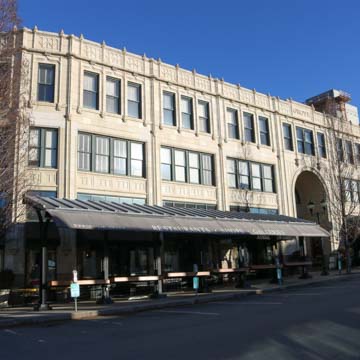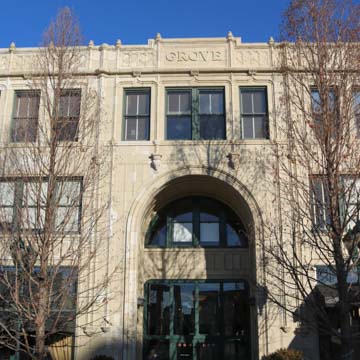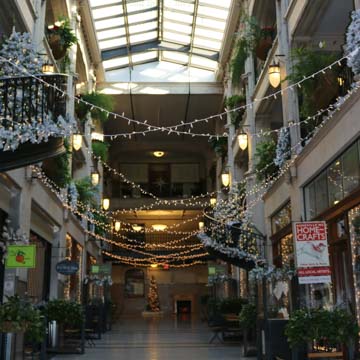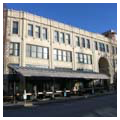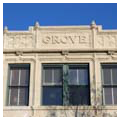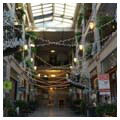You are here
Grove Arcade
Asheville has a compact and vibrant urban core. The eastern side is organized around Pack Square, where City Hall [NC-01-021-0065] is located, while the Grove Arcade is at the heart of the western end, its 270,000-square-foot mass occupying an entire city block between Battle Square and Page, Battery Park, and O Henry avenues. This ambitious project was conceived by developer Edwin Wiley Grove, known as the father of twentieth-century Asheville.
Grove, a wealthy patent medicine manufacturer, had first come to the Blue Ridge Mountains for his health, and saw the area’s potential as a resort, establishing the Grove Park Inn in 1912. By the 1920s, Asheville had become a booming tourism hub hosting some 250,000 visitors annually. Grove saw an opportunity for development and cleared and graded the hill on which the Battery Park Hotel (1886) once stood, in order to construct a new hotel (1924, W.L. Stoddard) and a massive commercial mall with covered pedestrian walkways, rooftop terraces, and a central tower. Work on the building stalled following Grove’s death in 1927 but resumed in 1928 under the ownership of Walter P. Taylor. Due to the stock market crash of 1929, the Arcade was completed without the tower.
The building is largely supported by a reinforced concrete frame, except at its center where a steel frame was built to support the intended tower. The facades are clad an ivory granite blocks trimmed by glazed terra-cotta ornaments and decorative elements in the Tudor Revival style. The north facade, which contains the main entrance, includes two large ramps that lead to a roof garden from which the surrounding mountains can be viewed. Griffins greet visitors at the base of each ramp, while the second level contains three trapezoidal panels featuring iconographic representations of various occupations, including an image of the architect, Charles N. Parker. The building is two stories at the north end but three at the south, where the site slopes down toward Battery Park Avenue.
Four deep barrel vaults, with the name “Grove” in high relief, mark the major entrances at the mid-point of each side. These lead to the two interior pedestrian streets—one north-south, the other east-west—that cross at the center and organize the building’s circulation. The longer north-south passage has a wire glass roof through which sunlight penetrates the interior and reflects off the travertine walls. Lining these passageways are smaller storefronts; rental offices are on the balconies above.
In 1942, the United States General Accounting Office’s Postal Accounts Division relocated from Washington, D.C. to Asheville, and the Grove Arcade was deemed the only structure large enough to house the federal agency. The National Climatic Data Center, predecessor of the National Oceanic and Atmospheric Administration, was housed here in the 1950s. The federal government occupied the building until the 1990s. In 1985, city leaders began working toward the restoration of the Arcade to its original commercial use. In 2002 the Grove Arcade reopened as a public market.
References
“Arcade Building.” National Register of Historic Places Travel Itinerary Asheville, NC. Accessed October 30, 2014. http://www.nps.gov/.
Bishir Catherine W. A Guide to the Historic Architecture of Western North Carolina.Chapel Hill: The University of North Carolina Press, 1999
Bishir, Catherine W. “Parker, Charles N. (1885-1961).” North Carolina Architects and Builders: A Biographical Dictionary. North Carolina State University Libraries, 2014. Accessed February 12, 2019. http://ncarchitects.lib.ncsu.edu/.
Hinson, Mary Alice, “The Arcade Building,” Buncombe County, North Carolina. National Register of Historic Places Registration Form, 1976. National Park Service, U.S. Department of the Interior, Washington, D.C.
Writing Credits
If SAH Archipedia has been useful to you, please consider supporting it.
SAH Archipedia tells the story of the United States through its buildings, landscapes, and cities. This freely available resource empowers the public with authoritative knowledge that deepens their understanding and appreciation of the built environment. But the Society of Architectural Historians, which created SAH Archipedia with University of Virginia Press, needs your support to maintain the high-caliber research, writing, photography, cartography, editing, design, and programming that make SAH Archipedia a trusted online resource available to all who value the history of place, heritage tourism, and learning.




















